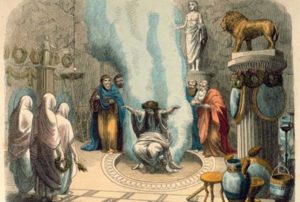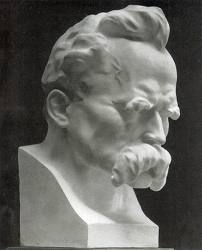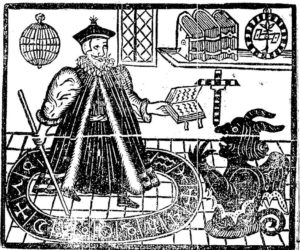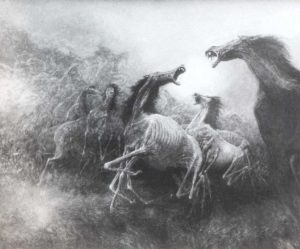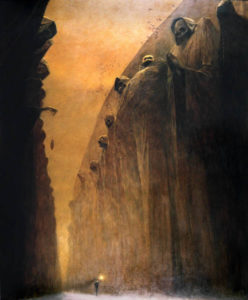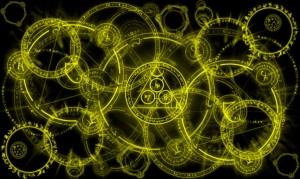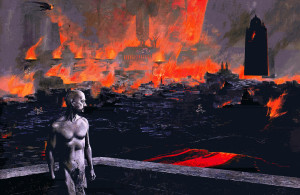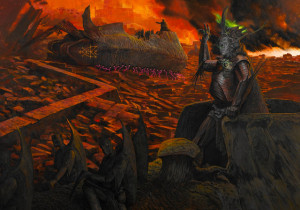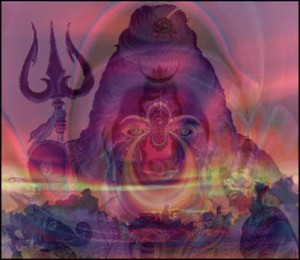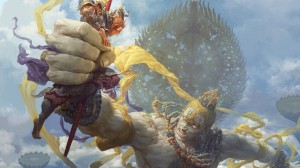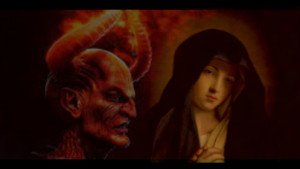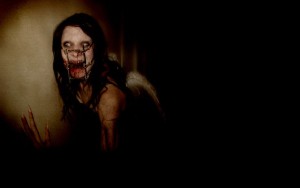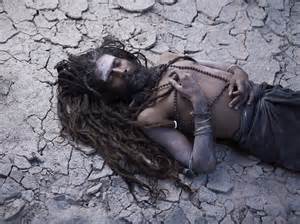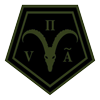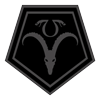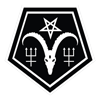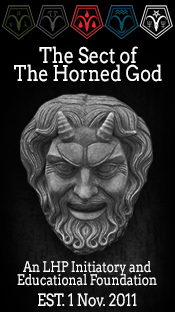The Ipsissimus
A short story by Thomas LeRoy
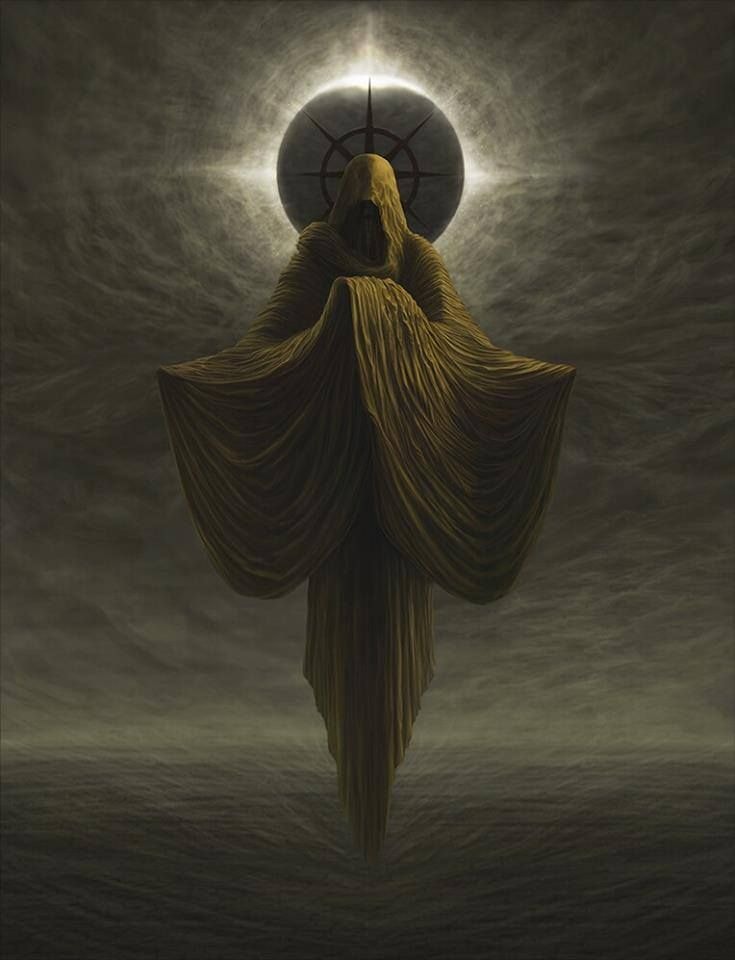
Since it goes without saying that you are reading this, it’s also obvious that a worthy, or maybe “receptive”, candidate has been located to relay this message. This communication is being transmitted by the will of the Ipsissimus, a conscious projection of pure thought from the primordial depths of the Dark Absolute, an admission of the one and only who found what lies beyond the collective unconscious in a void free of spatial — or temporal — configuration. But I’m getting ahead of myself.
Carl Gustav Jung believed the collective unconscious was a place, a location, where the archetypes dwell to send out their avatars: the gods and monsters, angels and demons. And others, besides myself, have visited this realm. And I know, beyond a shadow of a doubt, that Friedrich Nietzsche was one of them. He did not go mad from venereal poisoning, brain cancer, or that malady that removed his father from the corporeal layer once called “softening of the brain”. No, all are lies. Nietzsche was not a victim of madness, instead, he was a psychonaut that dared to venture into the collective unconscious. Now, one would state that that is no great feat, for many through the use of meditation, drugs, or ritual, have dipped a toe into its depths. The difference is that the Great Philosopher fully immersed himself into the Abyss by sheer will, and he retained his ego — his conscious identity — in the abode of the archetypes.
Still don’t get it?
Let me explain it this way: When one delves into the deep subconscious the ego is dissolved, it becomes one with the greater collective, like a water balloon popped in a filled tub, thus resulting in the temporary annihilation of the mind’s personal identity. I am convinced that Nietzsche’s ego never became one with the collective unconscious, that he took it whole and intact into that abysmal profundity, and what was left behind, that body, was but a husk, a husk his horrid sister utilized in a dreadful case of exploitation and psychogenic incest. But I am not Nietzsche, for a mind such as his only comes about once in a millennium, and that being so, I must utilize other means to achieve that ultimate goal of all dark adepts — apotheosis. And going head-first into the collective unconscious with one’s ego intact is a shortcut to that goal. Lucky for me finding aid in my quest would not be all that difficult for I am the owner of an occult bookstore. Located in an old Victorian that predates San Francisco’s 1906 Earthquake, it’s filled with beautiful hardwood shelves lined with candles, herbs, rings, pendants, and those wonderful leather-bound tomes — sans paperbacks. This store is perhaps the last of its kind in California, a state where you mostly find “New Age” book-sellers of inane drivel and not sellers of truly “occultic” content. Much of my sales are done online, but there are still a surprising amount of walk-ins. I’ve owned the store for twelve years, purchasing it after inheriting a rather healthy sum from my otherwise worthless parents, they having died in a freak hot-tub accident. Their meaty cadavers stewed in that giant crock-pot for days, gray flesh sliding off bone (I wonder what it smelled like?). Eventually, this morbid scene was discovered by my sister, Nikolett. Since our parents were both from Hungary, I referred to the affair as the “Goulash Incident” to the local media and after all these years my sister still won’t speak to me. Oh well.
Trying to retain a business in California is no easy feat, and this being San Francisco the homeless have compounded the problem. Begging, shooting up, shitting, pissing, and passing out on the sidewalk in front of one’s establishment can put a damper on business. And sometimes these “urban campers” pitch tents right in front of my door, with no regard for me or my customers.
On that rainy-gray morning in December, it was no different. A tiny blue dome tent, held together with duct tape, sat there before the door to my bookstore like a malignant growth.
“Hey,” I said as I shook the tent. “You gotta fuckin’ go.” There came no sound but that of traffic and the patter of rain on the tent. “I’m not fuckin’ around. You gotta go!”
“What . . . ?” came a gravelly voice from inside.
“You heard me.”
There was a long pause, then, “Okay. But the rain . . .”
“That’s your God damned problem!”
“Okay.”
“Now!”
The tent zipped open and out crawled a large being in a filthy yellow hoodie. He slid out like a maggot being squeezed from a zit.
“Holy fuck . . . ” I said, just above a whisper.
He slowly came to his feet and stood before me, tall, much taller than me. Hunched and disheveled, his eyes were tiny deep-set black orbs in a jaundiced face that was a twisted mass of scar tissue — that, I swear, moved! I don’t mean like a tic or a muscle twitch, but undulated, squirmed, like a bowl filled with earthworms. And he smelled of piss or patchouli, I couldn’t tell which.
“You have the book,” he said. I don’t think it was a question.
Looking at that face inside the hoodie caused an awful sensation, like icy spiders crawling up my spine. This bastard creeped me the fuck out.
“I have lots of books,” I said. “Now, go!”
“The play.” A thick, dirty hand gestured toward the door to the bookstore.
“Get out of here,” I said.
“The book . . . the play,” he said again.
“I don’t know what the fuck you’re talking about,” I said as I pointed down the street. “But you gotta go!”
He stared at me with those wet, beady eyes, then sighed. I watched as he went down on his knees and reached into his tent pulling out a plastic bag that I guess was stuffed with his treasured belongings. He stood and grabbed his tent, whole, not bothering to close it up.
“Have you seen the yellow sign?” he whispered.
“What?”
“Have you seen the yellow sign?” he said louder.
“What did I say?”
He began to walk away, the tent in one hand, bag in the other, and for a third time he muttered over his shoulder, “Have you seen the yellow sign?”
“Fuck you.”
As I unlocked the door I kept an eye on the lumbering hulk until he disappeared around the corner onto Taylor Street. I wiped the rain from my face and stepped inside.
I remember the first time I set foot in Lilith’s Grotto Bookstore and Occult Supplies back about twenty years ago. The smell. Besides the perfume of incense, herbs, and candles, there was the scent of old leather and old paper. After a while I couldn’t smell that potpourri any longer, having grown accustomed to it. I missed it. Besides the average occult supplies, the store’s main reason for existing was those wonderful old volumes, especially the leather-bound ones of black, brown, gray, and, in some cases, dark green lining the shelves with pages of black ink filled with words, symbols, drawings, and sigils. I almost hated to sell them, some were very rare and expensive. Selling a single grimoire could keep me in the black for months. As a matter of fact later that very day I sold two, an 1839 Düsseldorf edition of Unaussprechlichen Kulten by Friedrich Wilhelm von Junzt, and a copy of The Grimorium Verum, dated 1817. After that second sale, I turned the sign over on the door, closing early.
But as I was about to lock up, the words of the bum from that morning came back to me. No, it wasn’t the bullshit about the “Yellow Sign”, it was what he said about “the book” and “the play”. I only had one book that was a play in the store. It was a copy of The King in Yellow, but it was kept in the back, locked up in a glass case with other equally rare — or in this case — abhorrent volumes. It was said that if read, or acted out, it would drive one mad. I don’t know if I really believed it, this information having been given to me by Mr. Blackburn, the old man that sold me the book along with the rest of the store. But knowing the psychological power of words, this was not far-fetched. Letters are symbols, powerful symbols, that if arranged in a certain order can speak both to the conscious and subconscious, wreak havoc, alter lives, and change the world. Why couldn’t the words in that play drive one mad?
Later that night, with my mind still twisting and turning, I had dinner with my cousin, Janos. He had just returned from India where he had spent his honeymoon. His new wife is a fine piece of ass named Carla. Anyway, I, the Ipsissimus, have absolute recall, so the following will be the conversation I had with Janos verbatim. Understand it takes place in a dimly lit restaurant amongst the rich and affected of San Francisco who consumed meals they first have to take pics of to post online; high-dollar meals the women will just vomit up and the men will shit out. I won’t bother with any extraneous nonsense, just the dialogue.
Here’s how it went:
“How’s the store doing?”
“Not bad. Sold two rare volumes today.”
“Nice. Did you make a few bucks?”
“More than a few.”
Have you heard from Geneviève lately?”
“No. She won’t speak to me. Even blocked me on Facebook and Twitter.”
“Well . . . you did screw the housekeeper. You’re still not speaking to Nikolett, either, are you? You’ve got a habit of alienating the important women in your life.”
“How could I not fuck Lupe? She’s beautiful! You’d do the same if you were in my position.”
“No, I wouldn’t. Did you forget that I just got married?”
“Where did you go on your honeymoon?”
“India, you dumb-shit.”
“I know that but where in India?”
“All over, but spent most of our time in Varanasi.”
“Cool. See any Aghori?”
“You mean the roadside attractions for gullible tourists?”
“Some Aghori, maybe.”
“Most.”
“I don’t know about that.”
“I think most of them are just fucked up losers who use the spiritual as an excuse. Even if some are legit, I don’t get the point.”
“It’s about going to extremes to reach a higher state of consciousness.”
“Sure.”
“No, really. They think excess, living an extreme lifestyle, will allow them to achieve an enlightened state. It’s like the ancient Greek cult of Dionysus or Bataille’s limit experience. Divine madness, if you will.”
“Sure.”
“Really.”
“So, I guess the junkies down in the Tenderloin must be buddhas then?”
“C’mon.”
What Janos said made me think of the bum in yellow from earlier this morning. Then it struck me like a blow to the forehead. I’ve been searching for my own spiritual apotheosis for years and now I had the answer! Divine madness!
The book. The play. The King in Yellow was the answer!
After dinner (which I paid for, even though Janos came up with the idea) I raced back to the bookstore and to that locked bookcase of the rare and abhorrent. I located the play on the second shelf between a copy of The Munich Manual of Demon Magic and The Arcana Diabolicus.
The Arcana Diabolicus. With that and the King in Yellow, I was sure to find the right combination leading to my “Awakening”.
I grabbed both books, the King in Yellow on top. On the old cloth cover was a design. I ran my fingers over the textured symbol which I guess was the “Yellow Sign”. I dared not open it, but when should I? When I was ready, ready to attempt my dive into the Dark Absolute. But only after I read verses from The Arcana Diabolicus to, let’s say, lubricate my entry into the Abyss. Tonight might work. Why not tonight? It was a Friday, I’d have the weekend. Besides, this wasn’t the Abramelin Ritual I was performing, it wouldn’t take months. It was to be an original work. But still, certain safeguards were unavoidable.
I went back out into the main storefront. There wasn’t much room with the many shelves, but there was an old wooden display table a few feet in front of the check-out desk I could move after I removed the books and knick-knacks. This I did with little effort. Now I had roughly a 15 x 10 space of dark, hardwood floor I could work with. Perfect. Grabbing chalk, candles, and salts, I began prepping. This being an older building, the only window was that on the front door, which was easily covered with the black cloth I had removed from the display table. Didn’t need the bums peeking in. I poured a line of salt just before the threshold, then I drew a triangle on the floor with the ubiquitous circle around it. Next came runes and sigils taken from The Arcana Diabolicus, filling most of the bare floor. Remember this is my ritual. How I prepare it, and how I perform it, is all up to me. The drawing of the sigils took about two hours. When I had completed them, I took three pillar candles, two red and one black, and positioned them at the three points of the triangle, the black candle to the west. I lit them, turned off the lights, stripped down to my waist, and sat in the triangle in the lotus position, The Arcana Diabolicus and The King in Yellow on the floor before me. I meditated for about twenty minutes before I reached for The Arcana Diabolicus. I read different verses out loud for about an hour, those that had meaning to me before I closed it and set it down. I took a deep breath. When I finally had the guts to do so, I took up The King in Yellow, flipped through the first few pages, then began to read.
At first, I did not read it aloud, attempting to grasp what it was about. The play had three main characters: Cassilda, Camilla and someone simply called “The Stranger”, who I think is possibly the King in Yellow himself. When I got to Act 1, Scene 2 of the play, I read it aloud:
“Along the shore, the cloud waves break,
The twin suns sink behind the lake,
The shadows lengthen
In Carcosa.
“Strange is the night where black stars rise,
And strange moons circle through the skies,
But stranger still is
Lost Carcosa.
“Songs that the Hyades shall sing,
Where flap the tatters of the King,
Must die unheard in
Dim Carcosa.
“Song of my soul, my voice is dead,
Die thou, unsung, as tears unshed
Shall dry and die in
Lost Carcosa.”
I fell silent and looked around. I felt okay and everything looked fine, my reality hadn’t morphed or dissolved.
Okay, continue reading.
But before I could utter the next word I felt light-headed. Then came a rush throughout my body, beginning in my head, then my chest, then into my gut, as though I’d been grabbed and pulled down. I dropped the book and put my hands flat on the floor, bracing myself. God, it hurt! My legs kicked out. I knocked over a candle. I let out a scream as my body tightened and spasmed. It was as though gravity had grown stronger, stronger by tenfold, maybe, I don’t know, but I couldn’t take it any longer and blacked out.
My eyes have opened, but I do not see the bookstore, no, but a reality beyond all-knowing. I am here and it is now, having just sent out the message, that which you have read. Oh, the sensation! I have done it! My soul swells, my awareness is wide, more open than all imagining. I am formless and can see in all directions all at once as though I am one great eye, one great pupil, I see all, all at once! Here is where I am. Here is who I am. I am the Ipsissimus! Greater than all the gods, those simple avatars of the archetypes, I am greater! Far greater! The Trimurti is but a slapstick comedy team compared to me, and Yahweh is a louse on my scrotum! I am even greater than the archetypes themselves! And their collective unconscious is but a small room filled with third-rate actors waiting to audition for parts in a play written by a hack. I’ve done it! From here I proclaim that the greatest of all goals has been accomplished! This, here, is where I am right now as I watch colors swirl, turn, dance. I watch the dance of the dense azure vapors play about like deep-sea tendrils, while tempestuous waves of violet crash against misty vermilion shores. I have found eternity and we are one! I am what was before the Big Bang, and what will be after the Big Crush. Time has no meaning to me because space has no meaning to me! Space is a parted curtain that I have stepped through and onto this stage of limitless possibilities!
What?
What’s this?
What now?
Once again I feel a tug at my soul, a pulling down. Down! What? This can’t be! I am . . . I fall! I’m falling! What? How can this be?! I fall, plummet! Colors all about me rush upward! Rush upward! The panic! The panic! How can this be? Tearing! Tearing! I feel pain! Pain? How?! I am the Ipsissimus!
It stopped. I have stopped. All is still, cloudy, lead-colored clouds, a fog. I have substance. I have a body. I am looking down. My body? I touch it. How? My feet are on the ground, slate-colored earth. How? I am watching as the fog clears, opens, and parts. And I see about me a city. A city? A city of great onyx domes and monolithic structures, rude imitations of Brutalist architecture, and above is a pale sky of black stars and before me a placid lake beyond which sets twin suns! This can’t be! I am the Ipsissimus! This can’t be!
I hear something, like the flapping of sails. I am turning. I look up. There before me, floating high above, is a great being, massive, in a yellow robe, a hooded yellow robe of creases and wrinkles, flapping slowly, massive! Is it winged? I don’t know, it could be winged.
The horror I feel! Horror beyond imagining! I scream! I am screaming! I shrink to my knees as my throat becomes raw. Why? Why am I screaming? It’s the pallid mask that the being wears, this great King in Yellow. I cough and gag as it slowly removes that mask, slowly, to reveal a face, a jaundiced face . . . a face that is a twisted mass of scar tissue, scar tissue that undulates, squirms, like a bowl filled with earthworms and I realize, I’m am not the Ipsissimus, but a vector for the Word! The word that is the madness of the Play, carrier of the mind virus!
Are you a Sinisterist?
By Thomas LeRoy ~ Founder of The Sect of the Horned God
What is Sinisterism? And are you a Sinisterist? If you’re on the left-hand path, then you very well could be.
The word sinister comes from the Latin word sinistra meaning left. Historically, the left side, and left-handedness, was seen as a negative in most cultures. An example would be if a bird flew by on your left side, it was a bad omen. The left was considered “evil” or “unlucky”, thus giving us the modern English meaning for “sinister”.
Sinisterism, though, is a little used word, but when it is, its most likely by the religious right when sometimes referring to the secular political left. But in the realm of the esoteric, Sinisterism, or Sinisterist, would refer to someone who walks the left-hand path but doesn’t quite fit within an established paradigm. You may not identify as a Luciferian, for example, or appreciate the direction contemporary Satanism is going, but you are still lured by what’s down the Path. You have a hunger that one single paradigm, or discipline, could not satiate, so you take a little of this, or that, from many different disciplines: Satanic, Luciferian, Hermetic, Dark Pagan, Hindu, and so on. Your interest is in the big picture, the philosophy, the psychology, the history and mystery that is the LHP.
For myself, it was Satanism that first put me on the Path. Now, with my personal psychological and philosophical maturation there also came an awareness of my autonomy, so the right-hand path with its societal conformity no longer had any appeal to me. So, like most “Dark Esotericists” in the Western World, Satanism was the first vehicle utilized on the Path. And being an individual with an obsessive nature, when I get into something, whatever it is, devouring all aspects of that topic tends to be the end result. Simply scratching the surface is never enough.
Druidism, the root of much of European esoteric thought, was the starting point followed by Hinduism, Asatru, the dark gods of the Greco-Roman traditions, and so on. Next came the philosophies that corresponded with the Path, and the psychology. Getting down to the foundation, to find that deep psychological under-current that transcends both space and time was the most important aspect.
Because of this, Satanism was not enough. Besides, there was a growing frustration in my gut for contemporary Satanism. It seemed to lose that spark ignited by Anton LaVey. Too many organizations, too many poorly written books, too much anger and pettiness, and so much watering down of the philosophy, now there’s even a right-hand path version. But still my nature was Satanic as codified by Lavey, but the title of Satanist no longer worked for me. Something different was in order. Something that better portrayed my general interest in that “Sinister Path” and all it had to offer. Something that better suited my interests and natural inclinations.
This is why the title of Sinisterist works for me.
Does this also sound like you? If so, then you, too, are a practitioner of Sinisterism and can claim the title of Sinisterist. Why not? You don’t like labels, you say? You say labels are for soap cans? Well boo-fuckin’-hoo, others will give you a label whether you like it or not, so you might as well beat them to the punch. Admit who you are.
You’re a Sinisterist.
Necromancers of the Gods
By Thomas LeRoy ~ Founder of The Sect of the Horned God
We have no symbolic life, and we are all badly in need of the symbolic life. Only the symbolic life can express the need of the soul – the daily need of the soul, mind you! And because people have no such thing, they can never step out of this mill – this awful, banal, grinding life in which they are “nothing but.”…Everything is banal; everything is “nothing but,” and that is the reason why people are neurotic. They are simply sick of the whole thing, sick of that banal life, and therefore they want sensation. They even want a war, they all want a war, they are all glad when there is a war, they say, “Thank heaven, now something is going to happen – something bigger than ourselves!” These things go pretty deep, and no wonder people get neurotic. Life is too rational; there is no symbolic existence in which I am something else, in which I am fulfilling my role, my role as one of the actors in the divine drama of life. — C.G. Jung
Why is there a suicide epidemic? Mass shootings? A a deep cultural malaise? Carl Gustav Jung would say it is because the citizens of the modern Western World have lost contact with symbols, such as the metaphors we know as “God” or “The Gods”. The gods are primordial aspects of our being, psychic images connected to the collective unconscious that cannot be fully rationalized. Jung theorized we needed these symbols to express that which could not be wholly known.
Though the gods are buried deeply within the human subconscious, most existed long before us. They were an inherent part of the minds of our primordial ancestors, beings now long extinct: Aphrodite was born to that first creature to display lust; Aries came into existence with the first being to kill another of its kind out of anger; Pan, with that first early, early being to experience irrational fear, etc.
For many thousands of years humankind led lives deep with symbolic meaning. The gods were everywhere and in everything. From the time of the ancient communal fires to the god of Abraham, the gods fed the psyche, bringing about a life-enhancing effect. Even though it’s believed (more often than not) by people without an understanding of metaphorical symbolism, Abrahamism, the preeminent religious philosophy in the West, with all its misuses and abuses, brought nourishment to those overwhelmed with the psychic chaos of being.
But with the Age of Enlightenment, and the escalation of scientific thought, the gods began to die. This deicidal slaughter became so great it caused the 19th century, atheistic German philosopher Friedrich Nietzsche to declare, “God is dead!” But even though he, personally, had no use for the Abrahamic god, Nietzsche saw God’s death as deleterious to the basic belief system of the West. Just as you may not need antidepressants to get through the day, there are many who do, and the removal of such could wreak havoc. Thus, the demise of the Abrahamic system put many people at risk of despair, or meaninglessness. This new atheistic understanding of the world could, or would, lead to pessimism, “a will to nothingness” that was antithetical to a life-affirming philosophy. A nihilistic world was what Nietzsche feared and he stated as such when he wrote:
“What I relate is the history of the next two centuries. I describe what is coming, what can no longer come differently: the advent of nihilism...”
And the events of the 20th century would prove him right.
What is the answer then? Where can one find meaning in a world that has murdered the gods? Many have turned to politics. This form of vehement religiosity is evident in the political tribalism so prevalent in the world today. Others have found the gods in technology, entertainment, and even the sciences. But these solutions are the equivalent to nourishing the body with junk-food — temporarily fulfilling, but detrimental in the long run.
For those on the left-hand path resurrecting the gods is the answer, but one must be wary when performing this act of necromancy. Those longing for a shepherd, fearful to venture forth, would rather follow the herd then carve out their own personal path, will not find solace on the left-hand path. The left-hand path is a dangerous road where the gods are not there to coddle you, but to shake you violently until you awaken to a reality most would rather ignore. They are gods, not of forgiveness and mercy, but dark entities longing to devour you. They are a reminder that the strength to suffer the tribulations of existence should come, not from the whims of the collective, but from your own personal will.
We, The Sect of the Horned God, are the necromancers of the gods. Reanimation of those ancient archetypes is what we have to offer. But the act of invoking is up to you.
Rebellion Vs Religion
By Eric ~ Member of the Sect of the Horned God
I base this essay on the YouTube video by Thomas LeRoy called The Sect Vs Online Satanists as it was moved me because of the message it held. In my mind, rebellion is a way of pushing back against views that you do not agree with, and in most cases, the views of teenagers. A teenager sees the world one way because he or she has not fully experienced everything that life has to offer. A rebellion should have purpose, it should mean something to those who are rebelling, and not have to do with religion.
Religion is a belief system that we are taught or learn as we grow and like some (myself included) the views can change over time. Thomas LeRoy and Mistress Babylon talk about how it shouldn’t matter to anyone what other religions do unless that religion affected us as children. I grew up Catholic and was forced to attend church. I never understood how the church could tell nuns and priests that they were not allowed to have sex, but the abuse of children was a hush hush situation. This is a fine example of who cares, and why rebel against something I cannot control?
To me a Satanist is his or her own god with his or her belief system and someone that respects all religion regardless of how he or she feels about that religion. I used to believe that way that I think today was ridiculous. How could anyone believe in Lucifer as the teacher or the bringer of light? A lot of these views changed for me after reading The Devil’s Apocrypha by John DeVito. Are we simply crazy for believing we are our own gods? Are all religions just mythology made up by man to help us sleep better? I don’t think we will ever have a true answer to these questions.
Like anything in life that we enjoy, we should not allow that thing to control our lives but rather allow it to help guide us only as far as we wish to go. Mistress Babylon talked about indulgence and not allowing this to justify you being an asshole. Yes we all need to calm down and stop pretending that we are somehow better than those who have different views. My path is not rebellion; my path is further knowledge about things I wish to understand.
In conclusion I see the path to enlightenment. I seek my new religion as a way of learning about what I was once told is wrong and taboo. The first time in my life I feel free of societies and families pressure to be part of something that I do not wish to be a part of. I will not pretend to have the answers because I purchased a satanic bible, and I will not pretend I have all the answers. I hope to one day meet others and learn from them as they help guide me to the truth. Religion should not be about hate or being considered and outsider due to sexual orientation, it should be about love and axcepting others for who they are.
Sanitizing History
By Lisa Corrine, Co-founder The Sect of the Horned
Let’s lower the cultural bar down yet another notch and blow our bubbles of hope to a shiny clean and collectively cramped future while whitewashing the past. Let’s ensure that future generations are ignorant of historical context and conflict, evolving laws, conquests and sorrows. Let’s bind their eyes, ears and voice from sight, sound and questions of how and why.
Monkey See, Monkey Do.
History doesn’t disappear despite how hard you try to force it within the coloring book lines even though the Mandela ones are still very pretty. It’s like chaining your demon to the root cellar wall and ignoring their cries. The interpretation of past events in the (dimming) light of a contemporary perspective, Presentism, is the ballad of the ignorant and bleat of the weak, a soap box to stand on where no arrows are thrown. A safe, brave, and courageous position, no doubt, yet you cried for compassion when your garden flowers died.
It’s a presumptuous position of turnabout bias.
The Satanic Alchemy of The Sect
by Thomas LeRoy
We are all aware that alchemy is the ancient art of changing something of seemingly little value (lead) into something precious (gold). But it can also be interpreted psychologically. Alchemists had, over the course of centuries, created a vast amount of symbolic images that directly corresponded to the anatomy of the unconscious which the psychologist Carl Jung had been mapping through his work with thousands of patients. He discovered, much to his amazement, that this ancient art was symbolically describing the journey the individual must take towards embodying one’s own intrinsic wholeness, what he called “the process of individuation.” Jung insisted that the psyche cannot be understood conceptually, but only through images or symbols. He stated that, “The alchemical operations were real, only this reality was not physical but psychological.” He also wrote, “I had very soon seen that analytical psychology [the psychology Jung developed] coincided in a most curious way with alchemy. The experiences of the alchemists, were, in a sense, my experiences, and their world was my world. This was, of course, a momentous discovery. I had stumbled upon the historical counterpart of my psychology of the unconscious.”
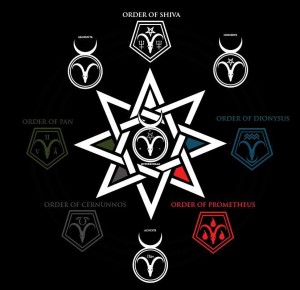
In The Sect of the Horned God the journey that the initiate takes as he/she progresses through the Orders can be described as an alchemical process. Each order has its symbolic element: Pan — Earth, Cernunnos — Air, Prometheus — Fire, Dionysus — Water. When the initiate has passed these four lower orders they become an adept, or Cenobite. The Cenobite utilizes the accumulated knowledge acquired in the Orders to bring about the quintessence, or fifth element, Aether. This process is done in the Order of Shiva to reach the degree of the Hyperborean. But If you are not willing to face what is sitting dormant in your subconscious, then the Order of Shiva may not be for you. This is where the Great Work, or the Transmutation, begins. You are the alchemical vessel and the contents of your psyche is the means and object of transformation. This alternative spiritual process cannot be reduced to simple recipes or axioms. It is the multi-level unification of microcosm with macrocosm to bridge the abyss between the ego and the subconscious; a descent into darkness in order to come to a reconciliation with your demon. This phase is the nigredo, or blackening phase of the alchemical process, and it is symbolic of coming to terms with this darker aspects of the Self.
But how does this come about?
First, for this process to work, you as a Satanist should have already come to the realization that you must divorce yourself from herd mentality. When your comfort zone becomes constrictive, like a beast outgrowing its cage, you must move beyond it. Still, only a few brave souls will venture beyond the walls of their self-imposed prison. If you are a member of The Sect, you have already done that. But still, spending a life-time of suppressing yourself, you have become a stranger to yourself. Alienation is felt as a chronic depression, deep inside. For some it is experienced at a greater level than others. Many try to numb it with a variety of means but there is no escape from yourself.
Through alchemical processes in the Order of Shiva you will come face-to-face with the Self, the Shadow Self, deal with its many complexities and learn to integrate it into your life. The world can be terrible, inexplicable and dangerous yet you must never surrender to pessimism by turning your back on it. Instead, learn to “transmute” the world and human life. Thus, you will become the Hyperborean (the Nietszchean “Higher Man/Woman) free from social constructs, attitudes, and restrictive dogmas with a strong will to power and its rational utilization. You will then accept the world in all of its highs and lows, mysteries and ambiguities having pulled yourself up out of ignorant bliss and stagnancy. You will find yourself amongst the doers, not the talkers, the maker and not the takers. You will be drawn to your processes, innovations, dreams and higher ideals. You will be aware and not ignore the arrival of peak experiences. Leave slave morality behind and have no guilt when you see yourself becoming compulsive and proactive.
When you have reached this stage, the game isn’t over, though. There is no “Aha!” moment where henceforth eternal bliss has been bestowed upon you. You must work to stay there. This is the point of individuation where the ego and the collective unconscious are brought into consciousness. It’s a fuller understanding of the Self and your individuality — a totally integrated personality. What you have done is accepted the contents of your unconsciousness, even those things that you would normally shy away from. It is the discovery of the divine in you. It is self-deification, the discovery of the god that you are.
The Left-Hand Path to Hell
by Thomas LeRoy
The concept of Hell has been a part of history for at least 4,000 years. Many different cultures had some form of Hell, the Mesopotamian being one of the earliest. It was a nether region filled with demons where the ancient Gods consigned evildoers to suffer endless torment. The later Christian interpretation of Hell was built upon Hebrew ideas, which in time became, like in the case of the Mesopotamian tradition, a place of punishment for the wicked. But in the Old Testament, there’s only one word which indicated anything close to Hell, and that is sheol. It appears originally to have been the Hebrews’ version of the Sumerian and Babylonian Irkalla, or Netherworld, also referred to more poetically as “the House of Dust and Darkness.” Strangely, early Christians did not write extensively on Hell and appear not to have taken it as literally as many do today. But when documented, Hell was pictured as an inferno, a place of flames and cruel heat, where Satan lived and sinners suffered as demons boiled them in kettles or stabbed them with pitchforks, punishments tailored to fit specific sins.
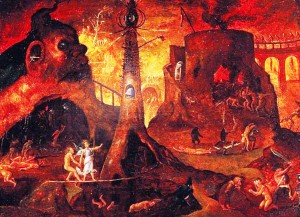
According to Carl Gustav Jung, Hell represents, among every culture, the disturbing aspect of the collective unconscious. The collective unconscious is universal. Every human being has been endowed with this psychic archetype-layer since his/her birth. One can not acquire this strata by education or other conscious effort because it is innate; for deep in our subconscious the same symbols speak to similar meanings across different cultures and unrelated time periods. The collective unconscious, this universal library of human knowledge, is the very transcendental wisdom that guides us. Jung stated that all religious experiences must be linked with the experience of the archetypes of the collective unconscious. Thus, all gods and demons, and even their locations such as Hell, are part of a psychic experience of the path that leads one to the realization of our psychic wholeness. In Jungian psychology, Hell would then be the place where the “shadow” resides. ‘‘The shadow,’’ wrote Jung, is ‘‘. . . that hidden, repressed, for the most part inferior and guilt-laden personality whose ultimate ramifications reach back into the realm of our animal ancestors and so comprise the whole historical aspect of the unconscious’’. The shadow was originally Jung’s poetic way of conveying the prominent role played by the unconscious in both psychopathology and the ongoing problem of evil. Also concerned with that pathological mental state known as ‘‘demonic possession”, Jung’s psychological construct of the shadow corresponds to, yet differs, from the idea of the Devil or Satan in theology. Born a parson’s son, Jung was inundated in the Protestant faith, he also studied the meaning behind Catholic iconography, and researched the great religious traditions from around the world. But, being a physician and psychiatrist, he used the more rational and less esoteric terms like ‘‘the shadow’’ and ‘‘the unconscious’’ instead of the traditional religious language of god, devil, or demons.
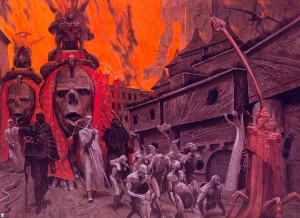
Just above the level of the collective Hell lies the personal Hell. This Hell is a place of personal demons that feed the shadow in the lower realm. And from time to time most of us feel a need to roam in this Hell. We all feel guilt, so we feel a need for torment, thus, we feel a need for Hell. The philosopher Friedrich Nietzsche described guilt as a disease that humanity caught when it formed its first social communities. But even though we live in artificial constructs we call nation states, under repressive executive authorities we call governments, our primitive instincts have never faded away. Instead, we turned our instincts for cruelty inwards upon ourselves because social laws prohibit violence. Because we internalize these instincts, we grow sick of existence. Nietzsche refers to this sentiment as the worst and most insidious illness ever to afflict human-kind. An illness from which we have not yet recovered.
So, as for us on the left-hand path, what are we to do? The collective hell is there whether we like it our not, but how should we confront this personal Hell of our own making? First, we must acknowledge that it is very real. Next, we must free up our minds and enter our personal Hell on our own accord, without that masochistic justification for torment created by guilt. We have to deny guilt and the Christian slave morality that permeates our society. In truth, we should have let guilt and slave morality go when we first set foot upon the Path. While in Hell, though, we must confront the dark entities that dwell in that abyss. We must stare them down, and in some cases, embrace them. But we should never turn our backs on them. Also, in the fires of Hell burns the source of our Black Flame, that spark of individualistic self-awareness. It was in our personal Hell that we first saw its glow, and from Hell we must lift it up and initiate it into our lives.
In the end we should never let our personal Hell curse our existence. It should be a means of empowerment for the Black Flame is fueled by Hell’s torments; and never forget that it is the Black Flame that lights our Path.
Understanding the Eastern Left-Hand Path Traditions
by Thomas LeRoy
Self-deification is not a proclamation, it is a process. One does not announce to the world that they are a god and henceforth reign supreme over all existence. Self-deification is something you strive to obtain, to reach, and once you have entered that state, you must work to remain there. You are then in a relationship with the deified self, and like any relationship you must work at it. A single slip-up and you can be cast out, back upon the Path, to try once more to re-enter. This is why it is important to have an arsenal of knowledge while proceeding down the Left-Hand Path. Some of you stepped upon the Path for the first time when you picked up The Satanic Bible. But The Satanic Bible was only your introduction. It was a mirror that you saw your reflection in. It was not the conclusion.
Reaching out, searching, learning about other modes of transport to help you down the Path is important. And understanding Eastern LHP philosophy is one way.
In the ancient Hindu traditions the Left-Hand Path, or the vamachara, was originally associated with the female aspect and the heterodox way. To put it simply, it is about reversing the natural spiritual flow. Eventually in the 19th century the Left and Right-Hand Paths were introduced into Western occultism by Theosophy founder Helena Blavatsky when she used them as terms to differentiate between white and black magick. To reach self-deification through the vamachara, or by any other practices, you must have a deep understanding of the Self. Atman, one of the most basic concepts in Hinduism, is the universal Self, identical with the eternal core of the personality. Atman is you, for in the early Vedas (holy Hindu writings) it occurred mostly as a pronoun meaning “oneself”. So atman is that which is then “deified” at the end of the LHP. Brahman, on the other hand, is the Absolute. Brahman underlies the workings of the universe, and atman is part of the universal Brahman. Brahman, in Vedic philosophy, is the “World Soul” and is regarded as being the “Three-in-One God” known as the Trimurti. This consists of Brahma the Creator, Vishnu the Preserver, and Shiva the Destroyer, all manifestations, or personifications, of Brahman.
Shiva, with his wild, unpredictable and destructive nature, is perhaps the ideal personification of the eternal core of the personality, or atman. His violent essence is often conveyed through the use of metaphorical images which are designed to resonate with the subconscious. However, Shiva’s destructive persona is not to be feared. The fury of Shiva’s fire only burns away the walls of ignorance. The atman is indestructible; thus, Shiva’s fire represents the awakening of the Self to its true nature and its god-like status. Because of Shiva’s association with the Self, some Shaivists have rebelled against the standards of the orthodox Hindu community. Believing that Shiva is the Self, they can make their own rules; and since all things, good or bad, are an aspect of the Absolute, nothing is taboo. Thus, they carry out bizarre sacrificial and sexual rituals, eat meat (sometimes human), and use mind-altering intoxicants while chanting “Shivoham!” — “I am Shiva!” They believe these activities to be short-cuts to self-deification. But they are not trying to become one with Shiva. Instead they long to deify the atman to become Shiva. A god!
You practitioners of the Western Left-Hand Path traditions may not have much interest in Eastern Philosophy. It may seem odd and confusing because in the Vedic traditions they attempt to say with words that which can not be said with words. It is metaphorical, it is poetry, and it is meant to be experienced, not critically analysed nor blindly believed. But still it is important that one is aware that there are other deities besides Satan and Lucifer that speak to our inherent nature. And Shiva speaks loudly. If you but only listen.
Satan and the Virgin Mary: Long Lost Lovers
by Thomas LeRoy
From the first glimmers of the primordial dawn, the Mother Goddess has had numerous interpretations and faces. Many early societies had a “mother-like godform” that honored the sacred feminine. A mother goddess is a personification of the Earth, the mother of all living things, of fertility and the birth of humanity as a whole. Besides the natural representations, Jungian interpretation equates the archetypal Mother Goddess with the feminine aspect within us all, and also with the greater unconscious, that “deepest ground of the psyche”.
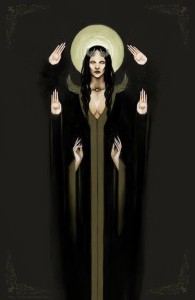
The list of names of the Goddess are endless, and the Virgin Mary, the mother of Jesus, is but one of them. Now, it goes without saying that the Christian mind may find this truth difficult to grasp, but the evidence for this is indisputable. For example, an obscure Early Christian heretical movement, Collyridianism, worshipped the Virgin Mary as a goddess. She was looked upon and worshipped as the supreme being, the Great Mother Goddess. And, as it turns out, “The Virgin” is a mythical character based on older goddesses who were themselves astrotheological personifications of celestial and earthly bodies and principles, the “Queen of Heaven”, prevalent in the ancient world. The old Teutonic goddess Hertha (the Earth) was a Virgin, but was impregnated by the heavenly Spirit (the Sky); and her image with a child in her arms was to be seen in the sacred groves of Germany. The Scandinavian Frigga, in much the same way, being caught in the embraces of Odin, the All-father, conceived and bore a son, the blessed Balder, healer and savior of mankind. Quetzalcoatl, the (crucified) savior of the Aztecs, was the son of Chimalman, the Virgin Queen of Heaven. Even the Chinese had a mother-goddess and virgin with child in her arms; and the ancient Etruscans also. There is the image of Isis nursing her Divine Son, Horus. And like the Christian Mary and Egyptian Isis, the Canaanite goddess Astarte was the “Virgin”. Thus this symbolism of the Goddess and her child has done a good job of expressing the relationship between consciousness and its divine matrix (the collective unconscious) as one of organic unity.
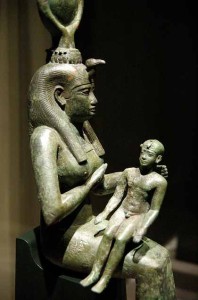
As most might be aware, it was common from the beginnings of Christiandom to adopt older heathen gods and turn them into saints . . . or devils. Castor and Pollux became St. Cosmo and St. Damien; Dionysus still holds his place as St. Denis of Paris. And the Horned God? It’s no stretch to guess who he became. But the relationship between the Neo-Pagan Horned God and the Christian Devil, or Satan, is a bit more complex than one might think. The modern Horned God is a composite of many pre-Christian deities, mostly the Greek Pan and the Celtic Cernunnos. But it was also influenced by Margaret Murray’s interpretation of medieval Christian devil imagery. In this sense, the Horned God is a modern “paganization” of the Devil, with his various animal characteristics representing the beastly nature of humankind; essentially a sacralization of our sexual nature. Thus, because of this exaltation of the beast within, the modern Christian equates the Pagan Horned God with Satan.
And who was, or is, the Horned God’s love-interest? The Goddess.
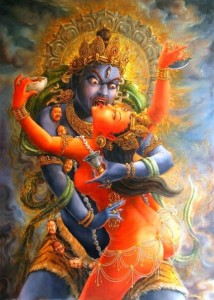
The Horned God and the Goddess, the “Divine Lovers”, represent the ontological polarity between the opposites of male and female common to many mythological traditions: Shiva and Shakti, Pan and Diana, Cernunnos and Brigit, etc. They are metaphorical representations of the Jungian Anima and Animus (the anima, the archetypal feminine symbolism within a man’s unconscious, while the animus is the personification of masculine psychological tendencies within a woman). This symbolism, though, is not found in the Abrahamic traditions. In most cases within this mythological structure the female aspect is vilified while the masculine is exalted. But this is not so in the case of the Goddess and the Horned God. The Goddess has been reinterpreted in a syncretic form into the Virgin, the most revered of all women, while the Horned God has become Satan. And why did they give the Horned God the name of the supreme bad guy in their mythos? Because they hate what He represents. He represents power, lust, carnality, death and knowledge. He is the free-thinking individualist ready to live life on His own terms. As stated before, He is our animal side, that aspect that keeps us tied down to the natural world. He is the antithesis of all that the Christians see as holy. And for their dogma to survive and for there to be calm within the flock, those traits of the human character have to be subdued. But the old time Christians weren’t stupid. They knew that the Horned God was a large part of what a human being is. So by telling the populace that who they are at their core is evil, and you need to kiss the ass of Jesus to be freed of that evil, they created an outstanding system of control. Thus in Christian society came a separation of these long lost lovers (Horned God/Goddess) within the psyche. But no good Christian would ever dream of a union between Satan and the Virgin. This being so, this stark division of archetypes has led to a psychological separation from the anima within the Christian man, and the animus within the Christian women. And by not bringing Satan and the Virgin Mary together, the Christian is an incomplete being.
A symbolic union of Gods and Goddess in the subconscious is important for the health of the psyche. This union of opposites is even evident in the image of that androgynous beast called Baphomet. But don’t worry, connecting with one’s inner male or female element has nothing to do with sexuality. It has everything, though, to do with creating a balance on the scales of passive (female) and aggressive (male) energies within us, which is essential for the development of self-awareness and personal understanding. These are important components of involution (as opposed to evolution) towards reaching the “Higher-Self”.
The Dark Aspects of Existence
by Thomas LeRoy
We know, in the deeper recesses of our minds, that each morning when we awaken we are one day closer to death, a death that will be, more likely than not, painful. But before that final curtain drops, we will endure heartache, loss, pain and suffering; a suffering that will sometimes seem insurmountable. And for many of us, if we are so lucky, the last thing we hear over the beep of a heart-monitor will be the lamentations of our loved ones.
Life is a bitch and then you die!
But what can we learn from this stark realization? Of facing our fears? Of facing death? What riches can we extract from these very dark aspects of existence?
“To those human beings who are of any concern to me I wish suffering, desolation, sickness, ill-treatment, indignities — I wish that they should not remain unfamiliar with profound self-contempt, the torture of self-mistrust, the wretchedness of the vanquished: I have no pity for them, because I wish them the only thing that can prove today whether one is worth anything or not — that one endures.”
–Friedrich Nietzsche
No matter how hard it may seem, the dark aspects of existence should not be seen as problematic. Instead, what’s really problematic is one’s attitude toward them. We must have optimism in the face of fear and suffering, for true psychological health involves affirming Life’s darker side.
“Aghora is not indulgence, it is the forcible transformation of Darkness into Light, of the opacity of the limited individual personality into the luminescence of the Absolute. Renunciation disappears once you arrive at the Absolute because then nothing remains to renounce. An Aghori goes so deeply into Darkness, into all things undreamable to ordinary mortals, that he comes out into Light.”
–Dr. Robert Svoboda
Aghora (which literally means “the Non-Fearful”), is a 1000-year old heterodox Hindu philosophy that follows an unconventional, radical path to spiritual fulfillment. Shiva the Destroyer, the embodiment of death, is their god and spiritual teacher, while the cremation grounds is their home. They believe that Shiva induced the best and worst of the world and nothing is profane, everything is sacred. They eliminate thoughts of duality between pure and impure, good and bad; denying perfection of anything would be like disrespecting the sacredness of life in its full manifestation. Hence, what other Hindu sects regard as unacceptable or taboo, these practitioners of the left-hand path embrace; they embrace the darker aspects of existence to help lead them to a higher level of consciousness. In the darkness they find gems of tranquil beauty. But how can we, too, find these jewels if we can see nothing in the inky depths of the dark?
By utilizing the Black Flame!
We, on the left-hand path, have a tool. It is a rare thing, this pilot-light of the soul/psyche. Not everyone has it, and only a few who do, know how to use it. It must be used to ignite a greater light, your personal fire! But for those on the right-hand path, they have received their light from another source, not from the personal. They have dipped their torches in a communal fire and use that flame to hurry through the darkness instead of studying it, learning from it.
The truth is the darker aspects of existence should be welcomed by those seeking spiritual fulfillment, for it is then, and only then, that true self-overcoming can be reached. So much more can be learned from pain than comfort. The most fulfilling human projects are inseparable from at least some degree of torment. In the end, we must stare into the abyss and find peace in its depths before we can truly laugh in the face of Death.

